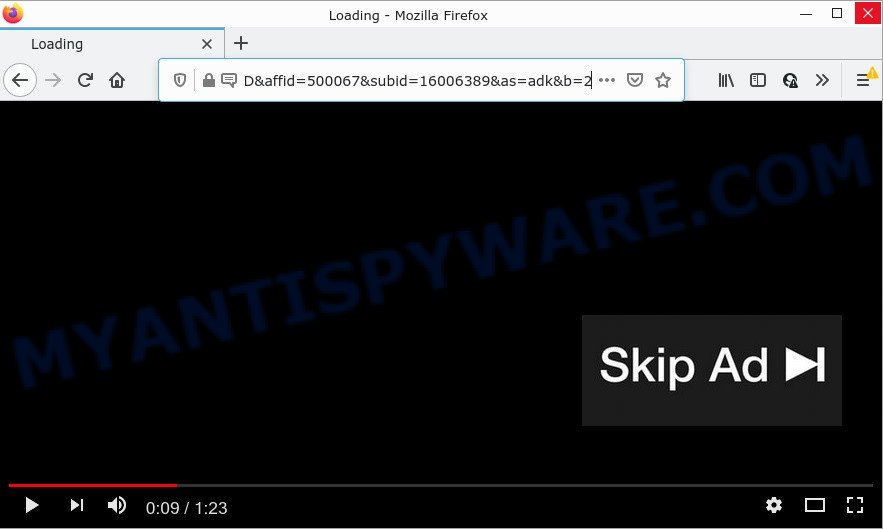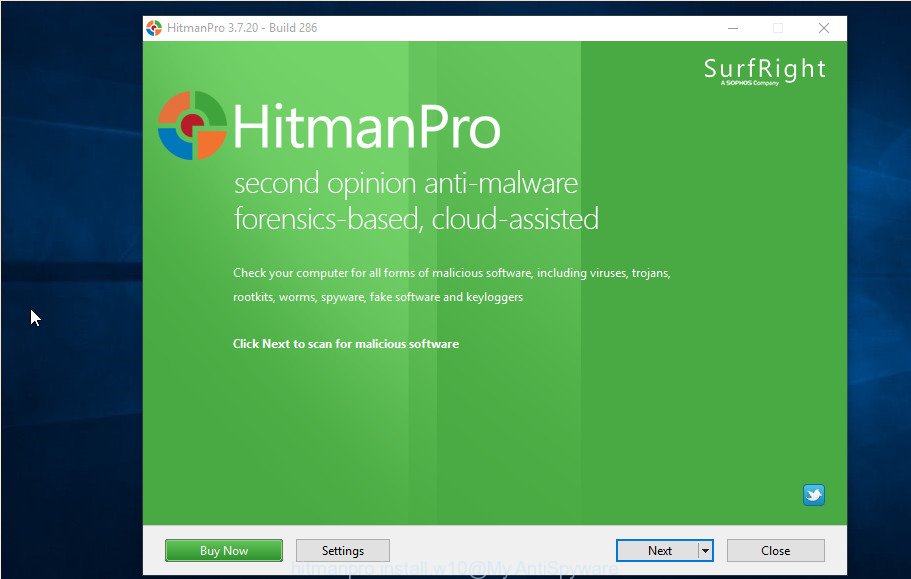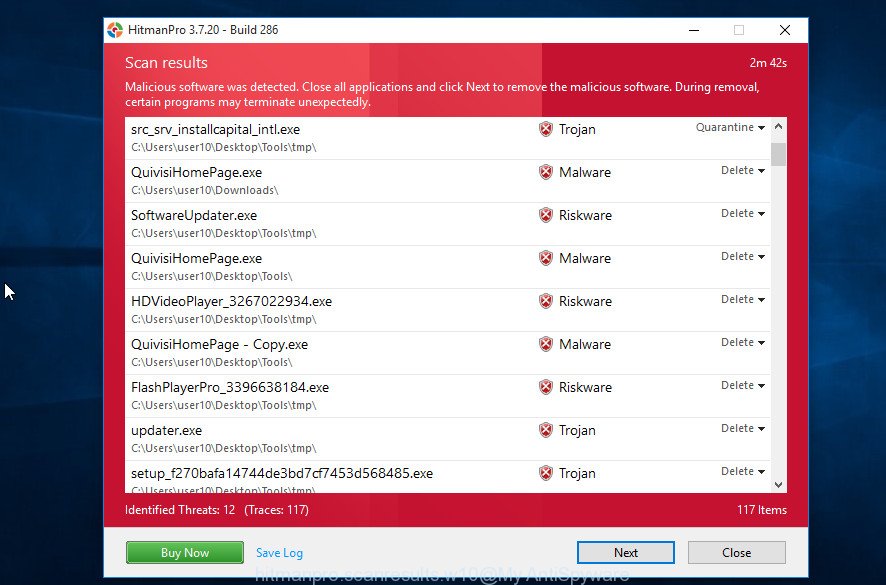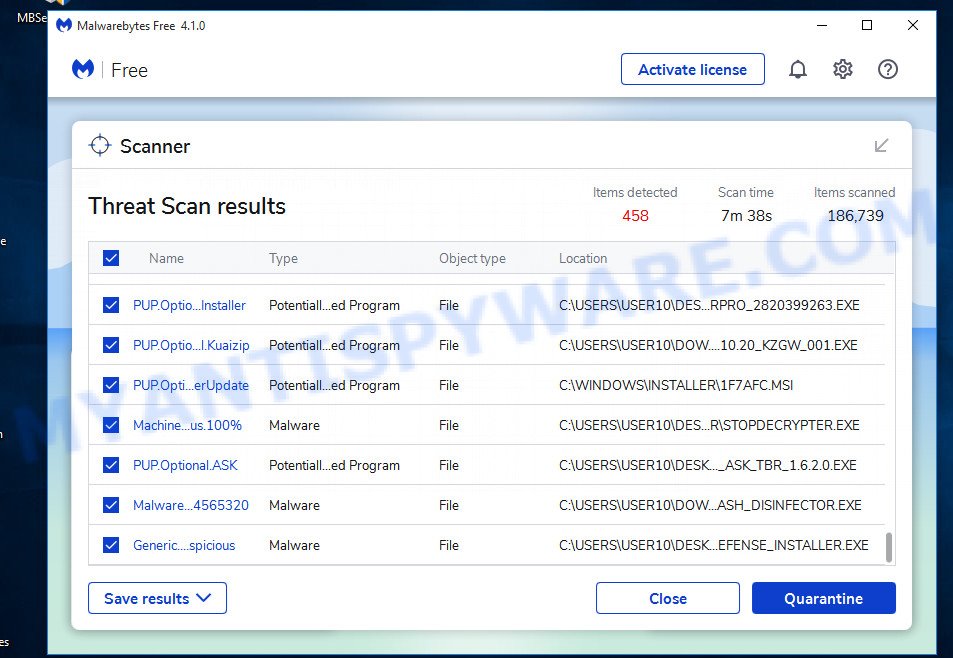What is Next-message.com?
Next-message.com is a website which deceives users into accepting push notifications via the web browser. Although push notifications cannot harm users directly, scammers use them to display intrusive ads, promote fake downloads, and encourage users to visit unsafe web-pages.

The Next-message.com web-site shows a confirmation request that attempts to get you to click the ‘Allow’ to subscribe to its notifications. Once you click on ALLOW, this web site starts sending push notifications on the desktop. You will see the popup advertisements even when the web-browser is closed.

Threat Summary
| Name | Next-message.com pop-up |
| Type | browser notification spam, spam push notifications, pop-up virus |
| Distribution | adware, potentially unwanted programs, social engineering attack, malicious popup ads |
| Symptoms |
|
| Removal | Next-message.com removal guide |
How did you get infected with Next-message.com pop-ups
Some research has shown that users can be redirected to Next-message.com from suspicious ads or by PUPs and adware. Adware is a part of malware that’s created to bombard you with unsolicited ads and pop-up windows that could potentially be dangerous for your computer. If you get adware on your PC, it can change browser settings and install malicious browser extensions.
These days certain free programs creators bundle potentially unwanted software or adware with a view to making some money. So whenever you install a new free programs that downloaded from the Net, be very careful during installation. Carefully read the EULA (a text with I ACCEPT/I DECLINE button), choose custom or manual installation mode, disable all additional programs.
Remove Next-message.com notifications from web browsers
If you have allowed the Next-message.com notifications by clicking the Allow button, then after a short time you will notice that these notifications are very intrusive. Here’s how to remove Next-message.com push notifications from your internet browser.
|
|
|
|
|
|
How to remove Next-message.com pop ups from Chrome, Firefox, IE, Edge
Fortunately, we have an effective way which will help you manually or/and automatically remove Next-message.com from your browser and bring your web browser settings, including new tab page, default search engine and start page, back to normal. Below you’ll find a removal guide with all the steps you may need to successfully get rid of adware software and its components. Read it once, after doing so, please bookmark this page (or open it on your smartphone) as you may need to close your browser or restart your computer.
To remove Next-message.com pop ups, perform the following steps:
- Remove Next-message.com notifications from web browsers
- How to manually remove Next-message.com
- Automatic Removal of Next-message.com advertisements
- Stop Next-message.com ads
How to manually remove Next-message.com
In this section of the blog post, we have posted the steps that will help to remove Next-message.com pop-up ads manually. Although compared to removal tools, this method loses in time, but you don’t need to install anything on the PC system. It will be enough for you to follow the detailed instructions with pictures. We tried to describe each step in detail, but if you realized that you might not be able to figure it out, or simply do not want to change the Windows and web browser settings, then it’s better for you to use tools from trusted developers, which are listed below.
Remove recently added adware software
The best way to start the PC cleanup is to delete unknown and questionable software. Using the Microsoft Windows Control Panel you can do this quickly and easily. This step, in spite of its simplicity, should not be ignored, because the removing of unneeded apps can clean up the MS Edge, Google Chrome, IE and Mozilla Firefox from popup ads, hijackers and so on.
Windows 8, 8.1, 10
First, press Windows button

After the ‘Control Panel’ opens, click the ‘Uninstall a program’ link under Programs category as on the image below.

You will see the ‘Uninstall a program’ panel like below.

Very carefully look around the entire list of applications installed on your computer. Most probably, one of them is the adware that causes multiple intrusive pop ups. If you have many applications installed, you can help simplify the search of harmful software by sort the list by date of installation. Once you have found a suspicious, unwanted or unused program, right click to it, after that click ‘Uninstall’.
Windows XP, Vista, 7
First, click ‘Start’ button and select ‘Control Panel’ at right panel like the one below.

When the Windows ‘Control Panel’ opens, you need to click ‘Uninstall a program’ under ‘Programs’ as displayed on the screen below.

You will see a list of software installed on your computer. We recommend to sort the list by date of installation to quickly find the programs that were installed last. Most likely, it is the adware that causes Next-message.com advertisements. If you are in doubt, you can always check the application by doing a search for her name in Google, Yahoo or Bing. After the application which you need to delete is found, simply click on its name, and then click ‘Uninstall’ as shown below.

Remove Next-message.com pop up advertisements from Chrome
If adware, other program or extensions changed your Chrome settings without your knowledge, then you can remove Next-message.com popups and return your browser settings in Google Chrome at any time. However, your saved passwords and bookmarks will not be changed or cleared.
First open the Chrome. Next, click the button in the form of three horizontal dots (![]() ).
).
It will show the Chrome menu. Select More Tools, then click Extensions. Carefully browse through the list of installed add-ons. If the list has the extension signed with “Installed by enterprise policy” or “Installed by your administrator”, then complete the following guidance: Remove Google Chrome extensions installed by enterprise policy.
Open the Google Chrome menu once again. Further, press the option named “Settings”.

The web browser will display the settings screen. Another method to display the Google Chrome’s settings – type chrome://settings in the web-browser adress bar and press Enter
Scroll down to the bottom of the page and click the “Advanced” link. Now scroll down until the “Reset” section is visible, like the one below and press the “Reset settings to their original defaults” button.

The Google Chrome will display the confirmation dialog box as displayed on the image below.

You need to confirm your action, click the “Reset” button. The internet browser will run the process of cleaning. After it’s done, the browser’s settings including startpage, newtab page and search provider by default back to the values which have been when the Chrome was first installed on your PC.
Remove Next-message.com from Mozilla Firefox by resetting web-browser settings
Resetting your Mozilla Firefox is good initial troubleshooting step for any issues with your browser application, including the redirect to Next-message.com web-site. Your saved bookmarks, form auto-fill information and passwords won’t be cleared or changed.
First, open the Mozilla Firefox and press ![]() button. It will open the drop-down menu on the right-part of the internet browser. Further, click the Help button (
button. It will open the drop-down menu on the right-part of the internet browser. Further, click the Help button (![]() ) as on the image below.
) as on the image below.

In the Help menu, select the “Troubleshooting Information” option. Another way to open the “Troubleshooting Information” screen – type “about:support” in the web browser adress bar and press Enter. It will display the “Troubleshooting Information” page like below. In the upper-right corner of this screen, click the “Refresh Firefox” button.

It will show the confirmation dialog box. Further, click the “Refresh Firefox” button. The Firefox will start a task to fix your problems that caused by the Next-message.com adware. When, it’s done, click the “Finish” button.
Remove Next-message.com pop up advertisements from IE
By resetting Internet Explorer browser you restore your browser settings to its default state. This is basic when troubleshooting problems that might have been caused by adware related to the Next-message.com pop up ads.
First, start the Internet Explorer, then click ‘gear’ icon ![]() . It will display the Tools drop-down menu on the right part of the web-browser, then click the “Internet Options” as shown on the screen below.
. It will display the Tools drop-down menu on the right part of the web-browser, then click the “Internet Options” as shown on the screen below.

In the “Internet Options” screen, select the “Advanced” tab, then click the “Reset” button. The Microsoft Internet Explorer will display the “Reset Internet Explorer settings” dialog box. Further, click the “Delete personal settings” check box to select it. Next, click the “Reset” button as displayed below.

After the procedure is finished, press “Close” button. Close the IE and reboot your device for the changes to take effect. This step will help you to restore your browser’s new tab page, search provider by default and startpage to default state.
Automatic Removal of Next-message.com advertisements
If you are not expert at computer technology, then all your attempts to remove Next-message.com ads by completing the manual steps above might result in failure. To find and remove all of the adware software related files and registry entries that keep this adware software on your PC system, run free antimalware software like Zemana AntiMalware, MalwareBytes Anti-Malware and Hitman Pro from our list below.
Use Zemana AntiMalware to remove Next-message.com advertisements
Zemana is a lightweight utility that developed to run alongside your antivirus software, detecting and removing malware, adware and PUPs that other programs miss. Zemana AntiMalware is easy to use, fast, does not use many resources and have great detection and removal rates.

- First, visit the page linked below, then click the ‘Download’ button in order to download the latest version of Zemana Anti-Malware.
Zemana AntiMalware
164813 downloads
Author: Zemana Ltd
Category: Security tools
Update: July 16, 2019
- At the download page, click on the Download button. Your browser will display the “Save as” dialog box. Please save it onto your Windows desktop.
- After the download is finished, please close all apps and open windows on your PC system. Next, start a file called Zemana.AntiMalware.Setup.
- This will launch the “Setup wizard” of Zemana AntiMalware onto your device. Follow the prompts and don’t make any changes to default settings.
- When the Setup wizard has finished installing, the Zemana will launch and open the main window.
- Further, click the “Scan” button to perform a system scan for the adware responsible for Next-message.com pop up ads. While the Zemana program is checking, you can see how many objects it has identified as threat.
- When finished, the results are displayed in the scan report.
- Make sure all threats have ‘checkmark’ and click the “Next” button. The utility will remove adware that causes Next-message.com ads and move the selected threats to the Quarantine. Once finished, you may be prompted to reboot the computer.
- Close the Zemana AntiMalware and continue with the next step.
Use Hitman Pro to remove Next-message.com popup advertisements
If Zemana Anti-Malware cannot remove this adware software, then we recommends to use the HitmanPro. HitmanPro is a free removal tool for hijackers, PUPs, toolbars and adware which causes the annoying Next-message.com ads. It is specially developed to work as a second scanner for your personal computer.
Installing the Hitman Pro is simple. First you will need to download Hitman Pro on your Windows Desktop by clicking on the following link.
When downloading is done, open the file location. You will see an icon like below.

Double click the HitmanPro desktop icon. When the tool is started, you will see a screen as on the image below.

Further, click “Next” button to scan for adware that causes Next-message.com pop-up ads in your internet browser. This procedure can take quite a while, so please be patient. After the system scan is done, Hitman Pro will open a list of all threats found by the scan as on the image below.

In order to remove all threats, simply click “Next” button. It will display a dialog box, click the “Activate free license” button.
How to delete Next-message.com with MalwareBytes AntiMalware
Trying to delete Next-message.com pop-ups can become a battle of wills between the adware software infection and you. MalwareBytes Anti-Malware can be a powerful ally, removing most of today’s adware, malware and potentially unwanted programs with ease. Here’s how to use MalwareBytes will help you win.

- Click the link below to download MalwareBytes Anti-Malware. Save it on your MS Windows desktop or in any other place.
Malwarebytes Anti-malware
327070 downloads
Author: Malwarebytes
Category: Security tools
Update: April 15, 2020
- After downloading is complete, close all software and windows on your computer. Open a file location. Double-click on the icon that’s named MBsetup.
- Choose “Personal computer” option and press Install button. Follow the prompts.
- Once install is complete, click the “Scan” button to perform a system scan for the adware software that causes Next-message.com popups. A system scan can take anywhere from 5 to 30 minutes, depending on your device.
- When that process is done, it will show the Scan Results. Next, you need to press “Quarantine”. After disinfection is complete, you can be prompted to restart your device.
The following video offers a few simple steps on how to remove hijackers, adware and other malicious software with MalwareBytes.
Stop Next-message.com ads
In order to increase your security and protect your personal computer against new unwanted advertisements and harmful webpages, you need to use ad-blocker program that blocks an access to malicious advertisements and web-sites. Moreover, the program can block the show of intrusive advertising, that also leads to faster loading of webpages and reduce the consumption of web traffic.
- First, click the link below, then click the ‘Download’ button in order to download the latest version of AdGuard.
Adguard download
26842 downloads
Version: 6.4
Author: © Adguard
Category: Security tools
Update: November 15, 2018
- When downloading is done, run the downloaded file. You will see the “Setup Wizard” program window. Follow the prompts.
- Once the setup is finished, press “Skip” to close the setup application and use the default settings, or click “Get Started” to see an quick tutorial that will help you get to know AdGuard better.
- In most cases, the default settings are enough and you don’t need to change anything. Each time, when you start your computer, AdGuard will start automatically and stop undesired advertisements, block Next-message.com, as well as other harmful or misleading web-sites. For an overview of all the features of the application, or to change its settings you can simply double-click on the icon called AdGuard, that can be found on your desktop.
To sum up
We suggest that you keep Zemana Anti-Malware (to periodically scan your PC system for new adwares and other malicious software) and AdGuard (to help you stop annoying pop up ads and malicious web-sites). Moreover, to prevent any adware, please stay clear of unknown and third party apps, make sure that your antivirus program, turn on the option to detect PUPs.
If you need more help with Next-message.com pop up ads related issues, go to here.


















